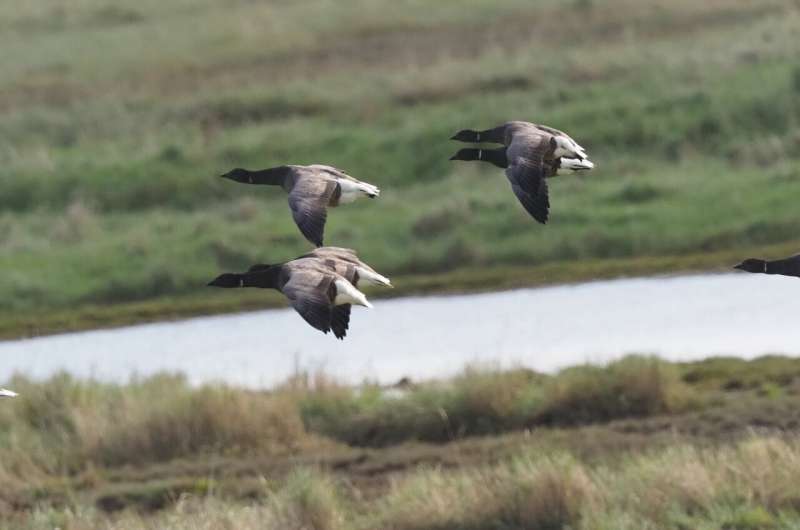This article has been reviewed according to Science X's editorial process and policies. Editors have highlighted the following attributes while ensuring the content's credibility:
fact-checked
peer-reviewed publication
trusted source
proofread
How do birds communicate? Network science models are opening up new possibilities for experts

Nature lovers will know the scene well. A flurry of birdsong, a shake of a tree and out pops a flock of birds flying away in unison together.
But how is it that the quick chatter of song among those birds led to that communal flight? A network scientist at Northeastern University in London has been helping experts to shed light on that question by mapping out how birds communicate when in groups.
Iacopo Iacopini, an assistant professor in the Network Science Institute, has been working closely with behavioral ecologists to provide "new insights" into vocal communication made by animals.
The research has been set out in Iacopini's paper, "Not your private tête-à-tête: leveraging the power of higher-order networks to study animal communication," published May 20 in the journal Philosophical Transactions of the Royal Society B: Biological Sciences.
Behavioral ecologists have for decades studied how one songbird is heard by another and then use that understanding to deduce how the one-to-one relationship functions—what is known as a dyadic interaction.
But experts knew that looking at it from that angle was overly simplistic when it is clear that a chirping bird will be heard by several birds in the surrounding vicinity.
Iacopini, along with colleagues from across the world, worked on modeling how birds interact with two or more others in theirs or rival flocks at the same time—what are referred to as higher-order networks.
The network scientists applied hypergraphs—a mathematical diagram showing how objects can have multiple connections simultaneously while in a group scenario—to better understand how light-bellied brent geese coordinate a group takeoff through increased squawks among the gaggle.
The scientists also did similar studies of the North American black-capped chickadees, creating a network to simulate the dawn chorus among what is a territorial family of birds in a bid to illustrate what interactions are occurring during that moment.
According to the five authors of the paper, mapping how these social structures play out has the potential to "reveal how vocal communication contributes to complex behavioral contagions within groups."
Iacopini said the trend among network scientists recently has been to focus on human interactions.
But he explained that the case studies he and his colleagues looked at for the paper in terms of non-human animal communication gave him a different kind of "playground" in which to map higher-order networks.
"Animals are another super important domain," Iacopini said. "Network scientists are already doing a lot of stuff on animal behavior but, in my opinion, not as much as for human interactions.
"I think that the non-human animal world represents another incredibly good playground for these approaches, because you can ask a lot of questions, you can track them, you can record their vocalization, you can track their movements."
Iacopini hopes that this paper and his experience collaborating with real-world wildlife data will encourage more partnerships between ecologists and network scientists.
"I personally would take this as a potential starting point for a lot of more research and projects on this leveraging," he said.
"It is also a call for attention from my side, to the network science community. I feel it might be the same for the animal behavior and ecology worlds—to bring the two worlds together to do better science, combining all the strengths of the two different teams now that we can have really good data-collection experiments."
Co-author Elizabeth Derryberry, a behavioral ecologist at the University of Tennessee who studies birdsong, agreed that the interdisciplinary project had yielded results and opened up "exciting" new possibilities.
She explained that the tools produced by the squad of network-mappers, which also included Nina Fefferman from the University of Tennessee and Matthew Silk from the University of Edinburgh in Scotland, allow those working in the field to identify patterns and make predictions about animal behavior.
Iacopini said he and the team of modelers enjoyed having their equations brought to life by ecologists.
"From our perspective, I think it is nice to see that some of the things that we do may actually go out in the field, instead of remaining on papers and publications online, and that is it," he said.
More information: Iacopo Iacopini et al, Not your private tête-à-tête: leveraging the power of higher-order networks to study animal communication, Philosophical Transactions of the Royal Society B: Biological Sciences (2024). DOI: 10.1098/rstb.2023.0190
Journal information: Philosophical Transactions of the Royal Society B
Provided by Northeastern University
This story is republished courtesy of Northeastern Global News news.northeastern.edu.



















